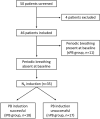Induction of Day-Time Periodic Breathing is Associated With Augmented Reflex Response From Peripheral Chemoreceptors in Male Patients With Systolic Heart Failure
- PMID: 35711301
- PMCID: PMC9197443
- DOI: 10.3389/fphys.2022.912056
Induction of Day-Time Periodic Breathing is Associated With Augmented Reflex Response From Peripheral Chemoreceptors in Male Patients With Systolic Heart Failure
Abstract
Spontaneous day-time periodic breathing (sPB) constitutes a common phenomenon in systolic heart failure (HF). However, it is unclear whether PB during wakefulness could be easily induced and what are the physiological and clinical correlates of patients with HF in whom PB induction is possible. Fifty male HF patients (age 60.8 ± 9.8 years, left ventricle ejection fraction 28.0 ± 7.4%) were prospectively screened and 46 enrolled. After exclusion of patients with sPB the remaining underwent trial of PB induction using mild hypoxia (stepwise addition of nitrogen gas to breathing mixture) which resulted in identification of inducible (iPB) in 51%. All patients underwent assessment of hypoxic ventilatory response (HVR) using transient hypoxia and of hypercapnic ventilatory response (HCVR) employing Read's rebreathing method. The induction trial did not result in any adverse events and minimal SpO2 during nitrogen administration was ∼85%. The iPB group (vs. non-inducible PB group, nPB) was characterized by greater HVR (0.90 ± 0.47 vs. 0.50 ± 0.26 L/min/%; p <0.05) but comparable HCVR (0.88 ± 0.54 vs. 0.67 ± 0.68 L/min/mmHg; p = NS) and by worse clinical and neurohormonal profile. Mean SpO2 which induced first cycle of PB was 88.9 ± 3.7%, while in sPB mean SpO2 preceding first spontaneous cycle of PB was 96.0 ± 2.5%. There was a reverse relationship between HVR and the relative variation of SpO2 during induced PB (r = -0.49, p = 0.04). In summary, PB induction is feasible and safe in HF population using simple and standardized protocol employing incremental, mild hypoxia. Pathophysiology of iPB differs from sPB, as it relies mostly on overactive peripheral chemoreceptors. At the same time enhanced HVR might play a protective role against profound hypoxia during iPB.
Keywords: carotid body; induction; periodic breathing; peripheral chemoreceptors; peripheral chemoreflex.
Copyright © 2022 Niewinski, Tubek, Paleczny, Banasiak and Ponikowski.
Conflict of interest statement
The authors declare that the research was conducted in the absence of any commercial or financial relationships that could be construed as a potential conflict of interest.
Figures








Similar articles
-
Prediction of the Chemoreflex Gain by Common Clinical Variables in Heart Failure.PLoS One. 2016 Apr 21;11(4):e0153510. doi: 10.1371/journal.pone.0153510. eCollection 2016. PLoS One. 2016. PMID: 27099934 Free PMC article.
-
The effects of P2Y12 adenosine receptors' inhibitors on central and peripheral chemoreflexes.Front Physiol. 2023 Jul 19;14:1214893. doi: 10.3389/fphys.2023.1214893. eCollection 2023. Front Physiol. 2023. PMID: 37538377 Free PMC article.
-
Analysis of Hypoxic and Hypercapnic Ventilatory Response in Healthy Volunteers.PLoS One. 2017 Jan 3;12(1):e0168930. doi: 10.1371/journal.pone.0168930. eCollection 2017. PLoS One. 2017. PMID: 28045995 Free PMC article.
-
Chemoreflexes--physiology and clinical implications.Acta Physiol Scand. 2003 Mar;177(3):377-84. doi: 10.1046/j.1365-201X.2003.01083.x. Acta Physiol Scand. 2003. PMID: 12609009 Review.
-
Carotid body modulation in systolic heart failure from the clinical perspective.J Physiol. 2017 Jan 1;595(1):53-61. doi: 10.1113/JP271692. Epub 2016 Apr 13. J Physiol. 2017. PMID: 26990354 Free PMC article. Review.
References
-
- Chua T. P., Coats A. J. S. (1995). The Reproducibility and Comparability of Tests of the Peripheral Chemoreflex: Comparing the Transient Hypoxic Ventilatory Drive Test and the Single-Breath Carbon Dioxide Response Test in Healthy Subjects. Eur. J. Clin. Invest. 25 (12), 887–892. 10.1111/j.1365-2362.1995.tb01962.x - DOI - PubMed
LinkOut - more resources
Full Text Sources
Research Materials
Miscellaneous

